|
|
|
Sort Order |
|
|
|
Items / Page
|
|
|
|
|
|
|
| Srl | Item |
| 1 |
ID:
166543
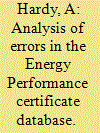

|
|
|
|
|
| Summary/Abstract |
Energy Performance Certificates (EPCs) are the adopted method by which the UK government tracks the progress of its domestic energy efficiency policies. Over 15 million EPCs have been lodged, representing a valuable resource for research into the UK building stock. However, the EPC record has a reputation of containing multiple errors. In this work, we identify many such errors and quantify how common they are. We find that 27% of EPCs in the open EPC record display at least one flag to suggests it is incorrect and estimate the true error rate of the EPC record to be between 36 and 62%. Many of these errors are caused by EPC assessors disagreeing on building parameters such as floor type, wall type and built form. Additionally, flats and maisonettes appear to cause more issues than other property types. This may be due to difficulties in assessing their location in the building and the nature of the surrounding space. We also suggest potential new methods of quality assurance which rely on machine learning and which could allow such errors to be avoided in the future.
|
|
|
|
|
|
|
|
|
|
|
|
|
|
|
|
| 2 |
ID:
166546


|
|
|
|
|
| Summary/Abstract |
Road transport accounts for 92 per cent of CO2 emissions from all transport services, and car transport makes the largest contribution to the total. We examine the dynamic relationship between car CO2 emissions in western European Union countries (EU-13) with the dieselization of the passenger vehicle fleet, technological progress, fuel efficiency, mobility indicator, economic activity and motorization rate. We take advantage of a panel data set of 13 EU countries between 1990 and 2015 and estimate a Dynamic Panel Data (DPD) model using alternative econometric methods. This approach allows us to estimate the effect on car CO2 emissions of induced indirect channels involving the reaction of economic agents to changes in aforementioned explanatory variables. We provide evidence that CO2 emissions have been benefited from global technological progress and changes in average fuel efficiency, while increases of economic activity, motorization rate and the dieselization process hold positive and significant relationship with car CO2 emissions. These results are consistent with alternative model specifications and econometric methods.
|
|
|
|
|
|
|
|
|
|
|
|
|
|
|
|
| 3 |
ID:
166503


|
|
|
|
|
| Summary/Abstract |
Community renewable energy initiatives are increasingly recognized as important actors to trigger citizen investments in renewable energy facilities. Little is known, however, about the factors that determine the size of financial investments made by community renewable energy members. To address this gap, this paper presents a multivariate econometric analysis of the economic, social, environmental and institutional determinants of the size of investments in community renewable energy. It relies on a large-scale survey of 4061 members of two renewable energy cooperatives located in Flanders, in the northern part of Belgium. Results show that the return on investment is the most important determinant for members of large communities of interest, while environmental, social and other non-economic drivers tend to dominate financial motives for members of smaller communities of place. The presence of other cooperative members in close social networks plays a particularly important role in the latter kind of communities, highlighting the strength of social interactions as a driver for investments. These results can help policy-makers to design more adapted policy measures for fostering financial investments at the community level, and project developers to tailor segmented communication strategies about the goals and benefits of projects.
|
|
|
|
|
|
|
|
|
|
|
|
|
|
|
|
| 4 |
ID:
166562
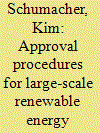

|
|
|
|
|
| Summary/Abstract |
This paper analyses the commonalities and variances of environmental approval procedures in four OECD territories, Japan, New Zealand (NZ), the European Union (EU), and the United States (US). In order to streamline regulatory approval frameworks for large-scale renewable energy (LS-RE) installations, outlining the strengths, as well as the weaknesses of the current systems in place, is crucial in determining what components to alter in line with national and regional particularities. The jurisdictional juxtaposition facilitates the identification of administrative burdens, which could increase environmental review-related costs for developers and prolong the entire approval process. Environmental impact assessment (EIA) frameworks, a major component of the LS-RE approval process, suffer from administrative fracturing between the local, regional, and national levels as well as between various government agencies. In combination with strong reservations from local civil society stakeholders, the results revealed some of the flaws of the current LS-RE project approval systems in place. The EIA frameworks and reform efforts in all four jurisdictions illustrate the importance of consolidated and comprehensive frameworks to reduce the amount of planning uncertainties for developers. Utilising regulatory tools such as mandatory timeframes, scoping, clear screening thresholds and priority assessment categories for LS-RE projects, could result in robust EIA processes based on unified regulatory procedures for climate change mitigating energy projects, inside as well as outside of OECD jurisdictions.
|
|
|
|
|
|
|
|
|
|
|
|
|
|
|
|
| 5 |
ID:
166506
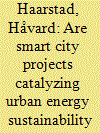

|
|
|
|
|
| Summary/Abstract |
The purpose of this paper is to investigate the links between smart cities and urban energy sustainability. Because achieving a “smart city” is a wide agenda rather than a specific set of interventions, smartness itself cannot easily be measured or quantifiably assessed. Instead, we understand smart cities to be a broad framework of strategies pursued by urban actors, and ask whether and how smart city projects catalyze urban energy sustainability. We use case studies of three cities (Nottingham, Stavanger, and Stockholm) funded by the Horizon 2020 Smart Cities and Communities program and examine how urban energy sustainability was advanced and realized through the smart city initiatives. We find first that while sustainability is not always a major objective of local implementation of smart city projects, the smartness agenda nevertheless increases the ambition to achieve energy sustainability targets. Second, the sustainability measures in smart cities are rarely driven by advanced technology, even though the smart city agenda is framed around such innovations. Third, there is significant sustainability potential in cross-sectoral integration, but there are unresolved challenges of accountability for and measurability of these gains.
|
|
|
|
|
|
|
|
|
|
|
|
|
|
|
|
| 6 |
ID:
166453


|
|
|
|
|
| Summary/Abstract |
This study aims at estimating potential future oil discoveries in Brazil by looking at the creaming phenomenon in past exploration trends. We apply a top-down modeling approach as fields' reserves are not disclosed. This study focuses on the four sedimentary basins which concentrate 95% of the Original Oil-in-Place (OOIP) discovered: Campos, Santos, Recôncavo and Potiguar. This work considers the 1P and 3P reserves to create a proxy for the volume of discoveries. Findings indicate potential to increase reserves by improving the recovery factor as well as by yet-to-find discoveries. We evidence such discoveries can be very sensitive to the function chosen to fit the creaming curve but also to the uncertainty in reserves estimates. Given the limited literature in Brazil concerning its exploratory potential, the creaming curve approach plays a vital role due to its relative simplicity and low data requirement. The methodology proposed in this study can be especially useful for many non-OECD countries where the availability of field-level data is limited.
|
|
|
|
|
|
|
|
|
|
|
|
|
|
|
|
| 7 |
ID:
166505
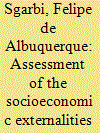

|
|
|
|
|
| Summary/Abstract |
Hydropower plants (HPPs) have played a key role in the Brazilian electric sector for over a century. As the different options for the generation of electricity are being increasingly scrutinized in terms of their sustainability, the assessment of the social, economic and environmental impacts has become a strategic factor to support investment decisions geared to expand the power supply. In this study, the construction and operation of a large group of Brazilian HPPs with over 100 MW of installed power was assessed based on the econometric analyses of 28 municipal indicators related to social, economic and environmental issues. Despite the broad variety of indicators analyzed, some environmental interferences typically attributed to HPPs such as a reduction in biodiversity and the interruption of fish migration routes were not assessed due to the lack of indicators. Overall, the study shows that the construction and operation of HPPs benefits mainly the economic activities. On the other hand, the indicators related to public health and safety, including the incidence of water-borne diseases and tropical parasitosis, bear no relation with the analyzed processes, except for the human fertility factor. In terms of Education, one of the indicators declined both during construction and operation stage.
|
|
|
|
|
|
|
|
|
|
|
|
|
|
|
|
| 8 |
ID:
166561


|
|
|
|
|
| Summary/Abstract |
Projected benefits serve as the driving force behind hydrocarbon development. Such benefits are analysed in conjunction with the risks posed by proposed oil and gas activities, leading to an ostensibly rational decision on whether to proceed with the development. This article explores the ways and extent to which government policies aimed at supporting the oil and gas sector affect the outcomes of decision-making processes regarding new hydrocarbon projects. The article is premised upon a case study of the Russian Arctic and Subarctic. The study utilizes transcripts of key presidential meetings and speeches, as well as applicable programmatic policy statements, laws, and administrative regulations. The data is subjected to the complimentary and corroborative discourse and legal analyses. The article concludes that the dominance of benefits over risks in the policy discourse is particularly impactful in the decision-making process regarding new oil and gas development in Russia.
|
|
|
|
|
|
|
|
|
|
|
|
|
|
|
|
| 9 |
ID:
166540
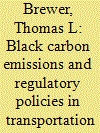

|
|
|
|
|
| Summary/Abstract |
The paper assesses evidence concerning the effects of transportation's black carbon emissions on climate change, public health, and food production; and it discusses policy issues posed by the emissions. Black carbon emission mitigation policies at all levels offer significant potential climate, health, and food co-benefits, and they are attractive in terms of economic cost-effectiveness and political feasibility. The paper presents an analysis of regulatory issues in maritime shipping and aviation, which are increasingly salient, and which are largely independent of the revelations of “diesel gate” in the motor vehicle industry. Yet, there are linkages in the technological and policy issues of the motor vehicle industry and issues confronting maritime shipping and aviation. Black carbon emissions are among the core regulatory policy issues in all three industries, and they have not been adequately addressed by policymakers. The paper concludes with specific policy recommendations at all governance levels.
|
|
|
|
|
|
|
|
|
|
|
|
|
|
|
|
| 10 |
ID:
166564


|
|
|
|
|
| Summary/Abstract |
Since the middle of the last century, the world has seen the emergence of Sovereign Wealth Funds (SWF). According to the Sovereign Wealth Funds Institute (2012), these legal entities can be defined as “a state-owned investment fund or entity that is commonly established from balance of payments surpluses, official foreign currency operations, the proceeds of privatizations, governmental transfer payments, fiscal surpluses, and/or receipts resulting from resource exports.” The SWFs are governed by the Santiago Principles, a document constructed by the IMF's International Working Group of Sovereign Wealth Funds (IWG) to recommend and to standardize the applications and investments of this kind of fund. SWFs are created in order to meet macroeconomic demands, using a series of investments strategies, which including foreign assets acquisitions. For instance, the Norwegian Government Pension Fund is one of the world's model SWFs. Its revenue is obtained from petroleum exploitation and is considered a savings fund, although part of the financial return can be applied in budget deficit. Following this example, Brazil created the Pre-Salt Social Fund to invest pre-salt petroleum revenues, and consists of a savings fund, according to the IMF classification. The present article focuses on the analysis and comparison of the legal structures of the Norwegian Government Pension Fund (GPF) and the Brazilian Pre-Salt Social Fund (SF), aiming to understand if the Brazilian fund applies the Norwegian standards.
|
|
|
|
|
|
|
|
|
|
|
|
|
|
|
|
| 11 |
ID:
166537


|
|
|
|
|
| Summary/Abstract |
Global warming is one of the issues of great concern in the world. The large-scale use of fossil fuels has led to the continuous increase in carbon emissions, resulting in global energy shortages and environmental pollution. Reasonable and strict environmental regulation promotes technological innovation by enterprises to achieve a win-win situation between the economy and environment, which is the core idea of the Porter hypothesis. The choice of China, as the world's largest energy consumer and carbon emitter, is not only related to the country's own mode of economic growth but also determines the development of the world's low-carbon economy. We used the panel data from 2000 to 2016 of 30 provincial-level administrative regions in China and adopted the Propensity Score Matching–Difference in Differences method to test the impact of China's carbon trading pilot system on the transformation of a low-carbon economy. The empirical results show that under the constraints of the established resources and environment, there is a positive relationship to some extent between China's carbon trading system and low-carbon economic transformation. This relationship can realize the win-win situation of environmental and economic benefits as advocated by the Porter hypothesis and further verify the applicability of the Porter hypothesis.
|
|
|
|
|
|
|
|
|
|
|
|
|
|
|
|
| 12 |
ID:
166521
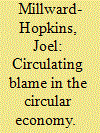

|
|
|
|
|
| Summary/Abstract |
The transition from coal-based electricity to ‘carbon neutral’ biofuels derived from forests has catalysed a debate largely centred upon whether woody-biofuels drive deforestation. Consequently, a crucial point is often missed. Most wood pellets used in electricity production are derived from waste-wood; a practice considered acceptable by many otherwise strongly opposed to the industry. We highlight that, precisely because waste-wood is a ‘waste’, its carbon-neutral credentials should be questioned. We then examine a parallel development occurring within the same industrial system; the recovery of electricity producers’ combustion-ash residues for concrete production. Contrasting how accounting practices allocate upstream carbon to these ‘wastes’ in the cases of wood pellets and coal-ash reveals how decisions are shaped by industry imperatives, rather than established lifecycle techniques. If the politics of emissions allocation continue to evolve in this way, it may become increasingly difficult to distinguish where progress towards a low-carbon, environmentally sustainable and circular economy is real, from where it is an artefact of biased and inconsistent accounting practices.
|
|
|
|
|
|
|
|
|
|
|
|
|
|
|
|
| 13 |
ID:
166547


|
|
|
|
|
| Summary/Abstract |
This study examines the Kyoto Protocol's impact on the international diffusion of renewable energy technologies including solar and wind energy. Using patent application data of 133 countries from 1990 to 2013 and a difference-in-difference approach, we find that the Kyoto Protocol increased international patent applications from the countries with emission targets. The effect appeared over many years during the period studied, particularly for solar energy technology. When we focus on countries with more stringent targets, the effect of the Kyoto Protocol is even stronger. For these countries, the Protocol's impact on the numbers of applications for international patent persisted strongly, even for wind energy technology. Moreover, we find a similar effect for the international patent applications filed in four developing countries that are large emitters of greenhouse gases: Brazil, China, India, and Mexico. These results suggest that the Kyoto Protocol stimulated international patenting activities from countries that are committed to stringent targets for climate mitigation. Our results endorse the importance of climate change agreements for international diffusion of technology.
|
|
|
|
|
|
|
|
|
|
|
|
|
|
|
|
| 14 |
ID:
166511


|
|
|
|
|
| Summary/Abstract |
In the layperson's imagination, energy is an abstract concept, disconnected from social and ecological realities, while in reality it is the cornerstone of all human and natural interactions; thus, energy policy can be seen as a representation of how part of nature has been appropriated, managed, and represented. This article offers an analysis of Colombian energy policy through its National Energy Plans, and an examination of the energy transitions that the country has experienced in the last forty years. The analysis of the Colombian case demonstrates that the central objective of energy planning and its institutional framework has been the advancement and maximization of the exploitation of energy resources for export purposes, instead of providing a guide to reorganize the system towards the reduction of energy consumption, the progressive replacement of non-renewable resources in favor of renewable sources, or energy justice.
|
|
|
|
|
|
|
|
|
|
|
|
|
|
|
|
| 15 |
ID:
166485


|
|
|
|
|
| Summary/Abstract |
Rural electrification project plans (REPP) aim to expand electricity access through adequate systems for communities without this service in developing countries. Many REPP have been developed, using different strategies in terms of energy uses covered, energy resources, electricity distribution and management models. This paper aims to analyze and compare REPP strategies. To do so, an evaluation methodology is developed, using a novel three-level assessment approach: the general definition at regional scale, the technical design at local scale, and the operation and maintenance (O&M) management. More specifically, ad hoc criteria are defined at each level to examine REPP fulfilment through quantitative and qualitative indicators. As case study, three plans from Chiapas (Mexico) are evaluated: national grid extension with national O&M; individual photovoltaic systems with regional O&M; and wind-photovoltaic microgrids with local O&M. Thus, the strengths and limitations of each REPP are identified in terms of strategies at regional scale, local scale and management model. Results show the ability of large plans to provide electricity to many families, while small plans may be adapted to the specific needs of end-users. The proposed criteria and indicators can be easily adjusted to evaluate REPP in different contexts to strengthen future plan strategies.
|
|
|
|
|
|
|
|
|
|
|
|
|
|
|
|
| 16 |
ID:
166479


|
|
|
|
|
| Summary/Abstract |
In this paper, we analyzed the competitiveness of an open-cycle gas turbine (OCGT) in the Korean electricity market and found reasons why OCGT has not been constructed since 2001, when the market opened. Through the analysis, we found that OCGT was weak in the Korean electricity market due to 3 factors: high load factor, high price of liquefied natural gas, and existing inefficient power plants. Using the conformity theory of the optimum in resource planning and the equilibrium in market dynamics, we verified the reasons by implementing resource planning using the Wien Automatic System Planning (WASP)-Ⅳ package with actual market data for the 16 years from 2001 to 2016. In addition, considering the new energy policy of Korea, shifting main sources of electricity generation from nuclear and coal to clean renewable energies and natural gas, we analyzed the competitiveness of OCGT in the future Korean electricity market. We identified the factors unfavorable for OCGT in the current market and suggested what should be changed to cope with high renewable energy penetration.
|
|
|
|
|
|
|
|
|
|
|
|
|
|
|
|
| 17 |
ID:
166576
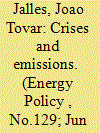

|
|
|
|
|
| Summary/Abstract |
In this paper, we empirically assess by means of the local projection method, the impact of different types of financial crises on a variety of pollutant emissions categories for a sample of 86 countries between 1980 and 2012. We find that financial crises in general lead to a fall in CO2 and methane emissions. When hit by a debt crisis, a country experiences a rise in emissions stemming from either energy related activities or industrial processes. During periods of slack, financial crises in general had a positive impact on both methane and nitrous oxide emissions. If a financial crisis hit an economy when it was engaging in contractionary fiscal policies, this led to a negative response of CO2 and production-based emissions.
|
|
|
|
|
|
|
|
|
|
|
|
|
|
|
|
| 18 |
ID:
166451


|
|
|
|
|
| Summary/Abstract |
This work discusses the development of hydropower in four Southeast Asia countries. With rapid economic development and insufficient energy supply, hydropower, as an important clean energy, plays a bigger role than before. It is shown that hydropower has immense potential and is the best choice to cater for the energy demand in Southeast Asia. In this work, Malaysia, Indonesia, Thailand and Myanmar are selected to analyze their hydropower development. This work introduces the status of hydropower resources, the current situation of hydropower development and the main distribution of hydropower stations in the four countries. In addition, the paper also introduces some energy policies, the development advantages and obstacles of the four countries, and puts forward suggestions for the future hydropower development of these four countries.
|
|
|
|
|
|
|
|
|
|
|
|
|
|
|
|
| 19 |
ID:
166532
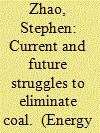

|
|
|
|
|
| Summary/Abstract |
Reductions in coal use necessary to meet the objective of keeping global temperature increase well under 2.0 °C faces serious political economic hurdles. To transition from coal, existing use must be eliminated and new growth in coal consumption must be stymied. Efforts to reduce existing consumption in a speedy manner faces challenges in domestically oriented markets where coal industry coalitions resist anti-coal policy and pursue industry protection. In addition, we identify a serious loophole in coal restraint exercised by a number of the users including: China, Japan and Korea. Continued support for coal capacity expansion abroad in both public and private sectors in these markets appears to reflect the lack of incentives, or sanctions in reining in such external capacity expansion. Such external expansion currently is not counted in nationally determined commitments for the Paris Agreement of the United Nations Framework Convention on Climate Change (Paris Agreement). Without greater national political efforts, the necessary reduction in coal use cannot be achieved.
|
|
|
|
|
|
|
|
|
|
|
|
|
|
|
|
| 20 |
ID:
166536
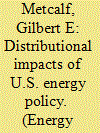

|
|
|
|
|
| Summary/Abstract |
This paper surveys energy policy in the United States from a distributional perspective. Focusing on the distributional impacts of energy taxes is too narrow a framework. The United States relies much more heavily on regulation than taxation to address energy-related market failures. It argues that most regulatory policies and tax subsidies to achieve energy policy goals are regressive. This includes fuel economy standards, EV purchase incentives, and energy efficiency tax incentives. In contrast, a carbon tax is likely to be progressive, even when ignoring the use of revenue. The view that carbon taxes are regressive stems from an incomplete distributional analysis that assumes all impacts arise from increases in the costs of consumer goods and services. Recent analyses have emphasized the importance of impacts on sources of income. In particular, a carbon tax is likely to reduce returns to capital more than wages. With capital disproportionately held by higher income households, this differential factor income effect is progressive. In addition, transfer income, more important for lower income households, tends to be indexed and so contributes to a carbon tax's progressivity. How carbon tax revenue is used can add even greater progressivity to a carbon tax reform.
|
|
|
|
|
|
|
|
|
|
|
|
|
|
|
|
|
|
|
|
|